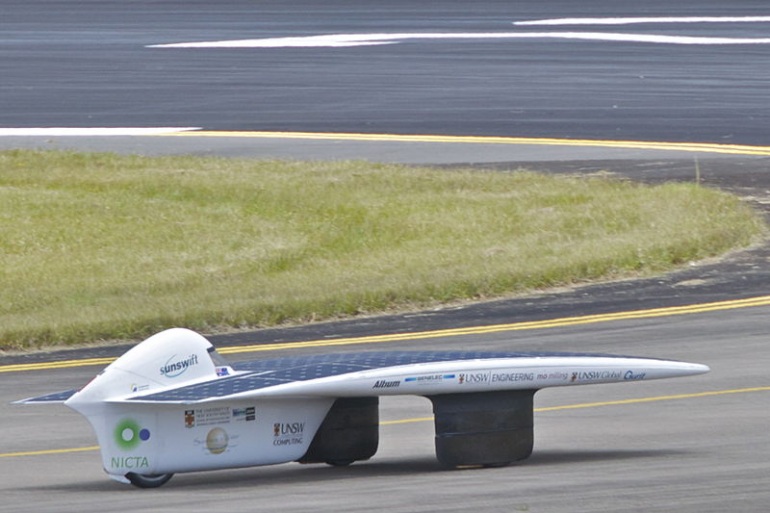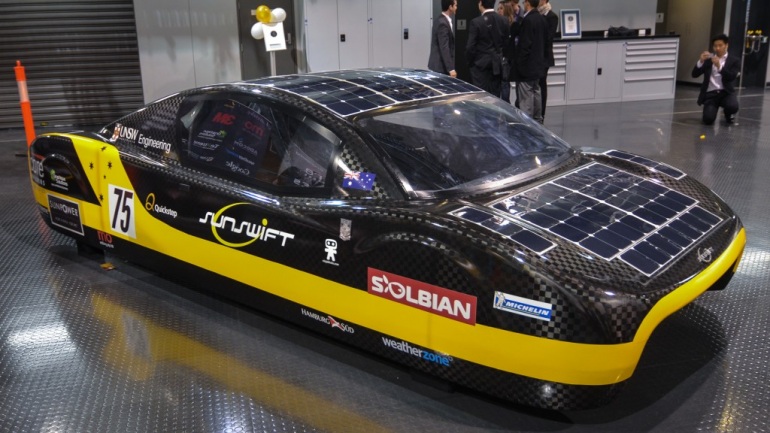A solar catalyst for the auto industry

Kevin Rudd’s $200 million promise to shore up Australia’s ailing auto industry has more to do with winning votes than actually delivering any long-term solutions to the sector. But then again, no amount of money is going to be enough for an industry that’s struggling to keep pace with a fundamental structural shift.
While the outlook remains gloomy, there is still plenty of talent in this country to ensure that Australia has what it takes to mix it up with the best when it comes to auto technology and perhaps therein lies hope.
One such display is the recent launch of The University of New South Wales (UNSW) new Sunswift “eVe” solar racing car.
Team Sunswift
Sunswift is the leading solar car racing team in Australia, and competes against world class institutions such as MIT, Oxford and Stanford in the World Solar Challenge. They compete on a tight budget (estimated at half a million dollars for 2013), which pales in comparison to some overseas rivals, some of whom enjoy generous financial backing from large automotive manufacturers such as Volkswagen and Ford.
Sunswift has achieved regular success. In 2011 Sunswift’s 4th generation race car Ivy broke the Guinness World Record for the fastest solar car, travelling at 88.783km/hour. Incredibly, this was achieved using less energy than a conventional 2 slice household toaster. This was the team’s second world record since first forming in 1996.
Project Manager Sam Paterson told Business Spectator that “Sunswift is a student-lead volunteer project, with team members enrolled in a variety of UNSW degrees including Engineering, Business, Science and Industrial Design.
Paterson estimated that a commercial operation would have had to spend over $5 million to achieve the same results as his team of volunteers. About 60 students are involved in the 2013 World Solar Challenge Sunswift team. About 30 students form the core of the team and they will each have spent well over 1200 hours working on this project by its conclusion.
The team recently raised over $27,000 through a successful Pozible crowd funding campaign, easily surpassing their $20,000 target. Paterson remarked that besides the much needed cash, unforeseen benefits of crowd funding included a lot of publicity from news articles all over the world and social proof to show the University how much Australians care about the future of research and manufacturing cars in Australia.
All about eVe
Sunswift’s latest 5th generation car design, eVe, moves away from pure racing and towards private transport applications. The team is competing in a new Michelin Cruiser class where the objective is not speed but practicality. Entrants must have four wheels instead of three, and must accommodate both a driver and a passenger.

This year’s car, unlike previous models, has four wheels, doors and is designed to be safer and more practical. Apart from the solar cells on the top surface its body shape looks much more like a standard road production car, departing from the typical spaceship design of most solar cars.
Paterson told Business Spectator that eVe had a single charge range of 500km, 140km/hr top speed and their “ultimate goal is to meet the requirements for road registration in Australia. We’re extremely confident in our latest design, and excited for the race in October.”
The team aims to race eVe this October in the World Solar Challenge – a grueling 3,000km race across the desert from Darwin to Adelaide. A race team of roughly 2 dozen people, eVe and several support vehicles will drive from Sydney to Hay to Port Augusta prior to the race, training between Port Augusta and the NT border.
History and future of electric cars
Electric cars were present at the very dawn of the automobile age. In the late 1800s they were competing against petrol and steam-powered vehicles to become the dominant motoring energy source.
Some electric cars had surprisingly aerodynamic designs capable of speeds that were unheard of in a personal vehicle. The first half-dozen land-speed records were all set by electricity powered cars, including the first motor vehicle to break the 100km/h speed barrier.
In 1898 a record of 62.78km/hr was set by Frenchman Gaston Chasseloup-Laubat in a Jeantaud electric car. Belgian driver Camille Jenatzy achieved several records before breaking the 100km/h barrier in 1899 with a new record of 105.26 km/h in his torpedo-shaped car named La Jamais Contente (‘The Never Satisfied’).
Indeed in the early 1900s it seemed that electric cars had a strong chance of becoming the mainstream form of motor vehicle for the new century. After all, even the Queen herself was driving one:
“If anything were wanting to invest the pastime of motoring with greater popularity in ladies’ eyes it is surely supplied by the fact that Queen Alexandra [wife of then British monarch Edward VII] has not only purchased for herself a Victoriette, but has learnt to drive it herself. Electricity is the motive force of the extremely smart little vehicle, with seats for two, that her Majesty has selected.” - The Sydney Morning Herald 29th June 1901
Although electric cars offered the benefits of less noise and no exhaust pollution during use, they lost out in the long run to the internal combustion engine. Petrol engines were cheaper to mass produce, and the fuel itself was relatively cheap with massive companies like Standard Oil backing it.
Look around at traffic in major Australian cities right now and you’ll struggle to spot any electric cars at all. Small-scale trials of electric cars are currently being run by several state and local governments.
How fast will the change take place? Carlos Ghosn, CEO and President of Renault and Nissan, predicts that roughly 10 per cent of the world’s car fleet will run on battery power alone by 2020. If the shift happens any faster it will be thanks to evangelists such as the UNSW Sunswift team attracting mainstream attention to electric cars.
Neerav Bhatt is an employee of UNSW













